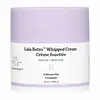What's inside
What's inside
 Key Ingredients
Key Ingredients

No key ingredients
 Benefits
Benefits

 Concerns
Concerns

 Ingredients Side-by-side
Ingredients Side-by-side

Lavandula Angustifolia Flower
Skin ConditioningVerbascum Thapsus Leaf Extract
Skin ConditioningOlea Europaea Fruit Oil
MaskingCitrus Aurantium Amara Peel
Skin ConditioningStearic Acid
CleansingButyrospermum Parkii Butter
Skin ConditioningTheobroma Cacao Seed Butter
EmollientGlycerin
HumectantCetearyl Alcohol
EmollientLilium Candidum Bulb Extract
Skin ConditioningHypericum Perforatum Extract
AntimicrobialSambucus Nigra Flower Extract
RefreshingViola Odorata Extract
Skin ConditioningHelianthus Annuus Flower Extract
Skin ConditioningIndigofera Tinctoria Extract
MaskingAlcohol
AntimicrobialTriethanolamine
BufferingMethylparaben
PreservativeParfum
MaskingPropylparaben
PreservativeLavandula Angustifolia Flower, Verbascum Thapsus Leaf Extract, Olea Europaea Fruit Oil, Citrus Aurantium Amara Peel, Stearic Acid, Butyrospermum Parkii Butter, Theobroma Cacao Seed Butter, Glycerin, Cetearyl Alcohol, Lilium Candidum Bulb Extract, Hypericum Perforatum Extract, Sambucus Nigra Flower Extract, Viola Odorata Extract, Helianthus Annuus Flower Extract, Indigofera Tinctoria Extract, Alcohol, Triethanolamine, Methylparaben, Parfum, Propylparaben
Water
Skin ConditioningGlycerin
HumectantCaprylic/Capric Triglyceride
MaskingIsopropyl Isostearate
EmollientPseudozyma Epicola/Camellia Sinensis Seed Oil Ferment Extract Filtrate
HumectantGlyceryl Stearate Se
EmulsifyingCetearyl Alcohol
EmollientPalmitic Acid
EmollientStearic Acid
CleansingPentylene Glycol
Skin ConditioningPlantago Lanceolata Leaf Extract
AntimicrobialAdansonia Digitata Seed Oil
EmollientCitrullus Lanatus Seed Oil
EmollientPassiflora Edulis Seed Oil
EmollientSchinziophyton Rautanenii Kernel Oil
EmollientSclerocarya Birrea Seed Oil
HumectantXimenia Americana Seed Oil
EmollientCholesterol
EmollientCeramide AP
Skin ConditioningCeramide EOP
Skin ConditioningSodium Hyaluronate Crosspolymer
HumectantCeramide NP
Skin ConditioningPhytosphingosine
Skin ConditioningCeteareth-20
CleansingTrisodium Ethylenediamine Disuccinate
Tocopherol
AntioxidantSodium Lauroyl Lactylate
EmulsifyingSodium Hydroxide
BufferingCitric Acid
BufferingCarbomer
Emulsion StabilisingXanthan Gum
EmulsifyingCaprylyl Glycol
EmollientSodium Chloride
MaskingSodium Carbonate
BufferingChlorphenesin
AntimicrobialPhenoxyethanol
PreservativeEthylhexylglycerin
Skin ConditioningWater, Glycerin, Caprylic/Capric Triglyceride, Isopropyl Isostearate, Pseudozyma Epicola/Camellia Sinensis Seed Oil Ferment Extract Filtrate, Glyceryl Stearate Se, Cetearyl Alcohol, Palmitic Acid, Stearic Acid, Pentylene Glycol, Plantago Lanceolata Leaf Extract, Adansonia Digitata Seed Oil, Citrullus Lanatus Seed Oil, Passiflora Edulis Seed Oil, Schinziophyton Rautanenii Kernel Oil, Sclerocarya Birrea Seed Oil, Ximenia Americana Seed Oil, Cholesterol, Ceramide AP, Ceramide EOP, Sodium Hyaluronate Crosspolymer, Ceramide NP, Phytosphingosine, Ceteareth-20, Trisodium Ethylenediamine Disuccinate, Tocopherol, Sodium Lauroyl Lactylate, Sodium Hydroxide, Citric Acid, Carbomer, Xanthan Gum, Caprylyl Glycol, Sodium Chloride, Sodium Carbonate, Chlorphenesin, Phenoxyethanol, Ethylhexylglycerin
 Reviews
Reviews

Ingredients Explained
These ingredients are found in both products.
Ingredients higher up in an ingredient list are typically present in a larger amount.
Cetearyl alcohol is a mixture of two fatty alcohols: cetyl alcohol and stearyl alcohol. It is mainly used as an emulsifier. Emulsifiers help prevent the separation of oils and products. Due to its composition, it can also be used to thicken a product or help create foam.
Cetearyl alcohol is an emollient. Emollients help soothe and hydrate the skin by trapping moisture.
Studies show Cetearyl alcohol is non-toxic and non-irritating. The FDA allows products labeled "alcohol-free" to have fatty alcohols.
This ingredient is usually derived from plant oils such as palm, vegetable, or coconut oils. There is debate on whether this ingredient will cause acne.
Due to the fatty acid base, this ingredient may not be Malassezia folliculitis safe.
Learn more about Cetearyl AlcoholGlycerin is already naturally found in your skin. It helps moisturize and protect your skin.
A study from 2016 found glycerin to be more effective as a humectant than AHAs and hyaluronic acid.
As a humectant, it helps the skin stay hydrated by pulling moisture to your skin. The low molecular weight of glycerin allows it to pull moisture into the deeper layers of your skin.
Hydrated skin improves your skin barrier; Your skin barrier helps protect against irritants and bacteria.
Glycerin has also been found to have antimicrobial and antiviral properties. Due to these properties, glycerin is often used in wound and burn treatments.
In cosmetics, glycerin is usually derived from plants such as soybean or palm. However, it can also be sourced from animals, such as tallow or animal fat.
This ingredient is organic, colorless, odorless, and non-toxic.
Glycerin is the name for this ingredient in American English. British English uses Glycerol/Glycerine.
Learn more about GlycerinStearic Acid is a fatty acid. It is an emollient, emulsifier, and texture enhancer.
As an emollient, stearic acid helps soften skin. It aids the skin's protective barrier by preventing water loss. It also provides a gentle cleansing effect without stripping away natural oils.
Stearic acid may also be used to enhance the texture of products. It can add volume and stabilize ingredients such as water and oil. This can help water and oil ingredients from separating.
Sources of stearic acid include animal or vegetable fats/oils such as coconut or shea. It can be naturally found in butter, cocoa butter, shea butter, vegetable fats, and animal tallow.
This ingredient may not be Malassezia folliculitis, or fungal-acne safe.
Learn more about Stearic Acid